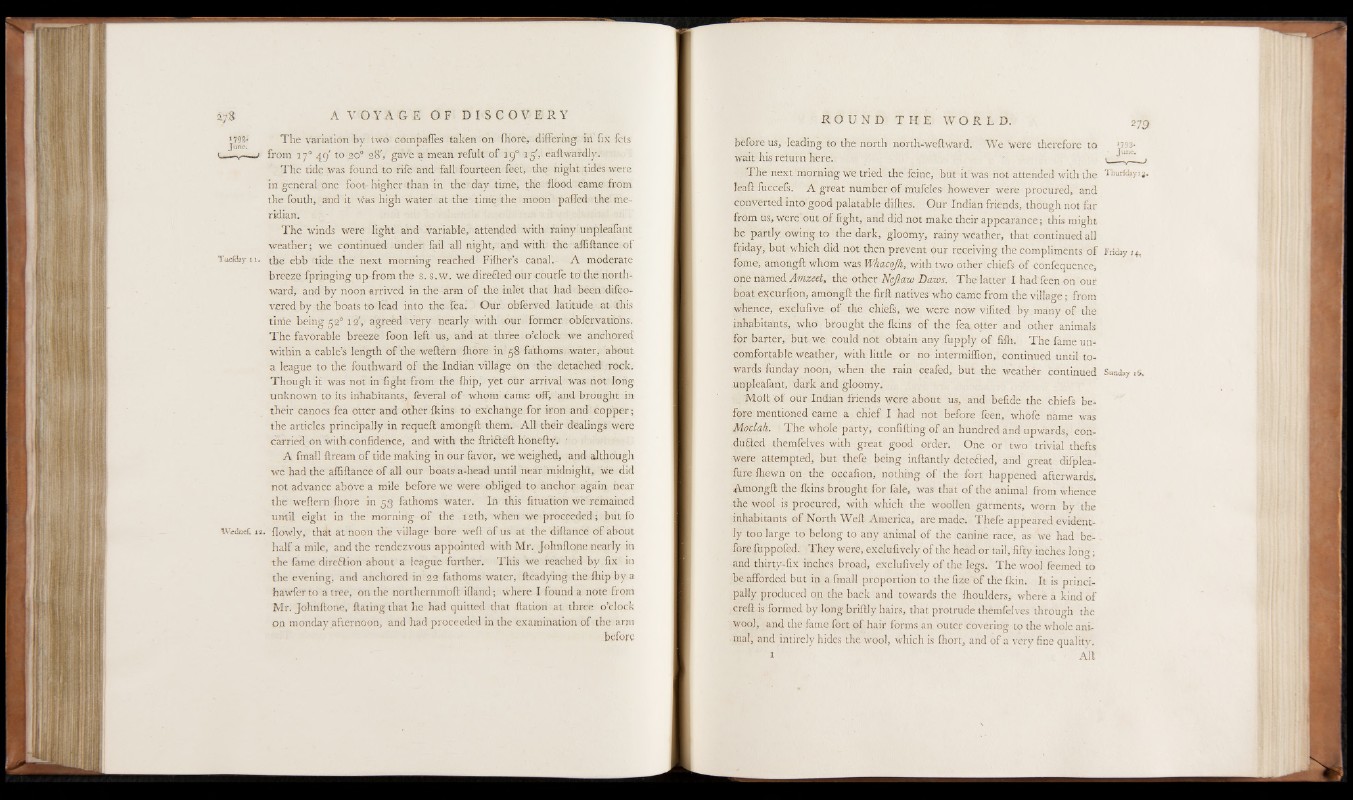
1793*
June.
Tueftky 11.
W^dnef. 12.
The variation by two compaffes taken on fliore, differing in' fix fets
from iy° 49' to 20° 28', gave a mean refult of 19° 15V eaftwardly.
The tide was found to rife and fall fourteen feet, the night tides were
in general one foot-higher , than in the'day time, the flood came from
the fouth, and it was high water at the time the moon pafled the meridian.
The winds were light and variable,; attended with rainy unpleafant
weather; we continued under fail all night, and with the afliftance of
the ebb tide the next morning reached Filher’s canal.- A moderate
breeze fpringing up from the s. s.w. we direfted our courfe to the northward,
and by noon arrived in the arm of the inlet that had been difco-
vered by the 'boats to lead into the Tea. Our obferved latitude at this
time being 52° 12', agreed very nearly with our former obfervations.
The favorable breeze foon left us, and at three o’clock we anchored
within a cable’s length of the weftern fliore in 58 fathoms water, about
a league to the fouthward of the Indian village on the detached rock.
Though it was not in fight from the fliip, yet our arrival was not long
unknown to its inhabitants, feveral o f whom came off, and brought in
their canoes fea otter and other Ikins to exchange for iron and copper;
the articles principally in requeft among!! them. All their dealings were
carried on with confidence, and with the llriclefl honefty. ’
A fmall ftream of tide making in our favor, we weighed, and although
we had the afliftance o f all our boats a-head until near midnight, we did
not advance above a mile before we were obliged to anchor again hear
the weftern fliore in 53 fathoms water. In this fituation we remained
until eight in the morning o f the 12th, when we proceeded; but fo
flowly, that at noon the village bore weft of us at the diftance of about
half a mile, and the rendezvous appointed with Mr. Johnftone nearly in
the fame direftion about a league further. This we reached by fix in
the evening, and anchored in 22 fathoms water, fteadying the fliip by a
hawfer to a tree, on the northernmoft ifland; where I found a note from
Mr. Johnftone, ftating that he had quitted that ftation at three o’clock
on monday afternoon, and had proceeded in the examination of the arm
before
before us, leading to the north north-weftward. We were therefore to
wait his return here.
The next morning we tried the feme, but it was not attended with the
leaf! fuccefs. A great number o f mufcles however were procured, and
converted into good palatable dilhes. Our Indian friends, though not far
from us, were out of fight, and did not make their appearance; this might
be partly owing to the dark, gloomy, rainy weather, that continued all
friday, but which did not then prevent our receiving the compliments of
fome, amongft whom was Whacojh, with two other chiefs of confequence,
one named Amzeet, the other Nejtaw Daws. The latter I had feen on our
boat excurfion, amongft the firft natives who came from the village; from
whence, exclufive of the chiefs, we were now vifited by many of the
inhabitants, who brought the Ikins of the fea. otter and other animals
for barter, but we could not obtain any fupply o f filh. The fame uncomfortable
weather, with little or no intermiffion, continued until towards
funday noop, when the rain ceafed, but the weather continued
unpleafant, dark and gloomy.
Moft of our Indian friends were about us, and befide the chiefs before
mentioned came a chief I had not before feen, whofe name was
Moclah. The whole party, confining o f an hundred and upwards, conduced
themfelves with great good order. One or two trivial thefts
were attempted, but thefe being inftantly deteCed, and great difplea-
fure fhewn on the occafion, nothing of the fort happened afterwards.
Amongft the Ikins brought for fale, was that of the animal from whence
the wool is procured, with which the woollen garments, worn by the
inhabitants of North Weft America, are made. Thefe appeared evidently
too large to belong to any animal of the canine race, as we had before
fuppofed. They were, exclufively of the head or tail, fifty inches long;
and thirty-fix inches broad, exclufively of the legs. The wool feemed to
be afforded but in a fmall proportion to the fize o f the fkin. It is princi-
pally produced on the back and towards the fhoulders, where a kind of
creft is formed by long briftly hairs, that protrude themfelves through the
wool, and the fame fort of hair forms an outer covering to the whole animal,
and intirely hides the wool, which is fhort, and of a very fine quality.
1 A ll
1793- June.
Thurfdayi 3.
Friday j 4.
Sunday i&,